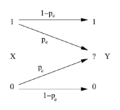ProofWe first show that  .
.
Let  and
and  be two independent random variables. Let
be two independent random variables. Let  be a random variable corresponding to the output of
be a random variable corresponding to the output of  through the channel
through the channel  , and
, and  for
for  through
through  .
.
By definition  .
.
Since  and
and  are independent, as well as
are independent, as well as  and
and  ,
,  is independent of
is independent of  . We can apply the following property of mutual information:
. We can apply the following property of mutual information: 
For now we only need to find a distribution  such that
such that  . In fact,
. In fact,  and
and  , two probability distributions for
, two probability distributions for  and
and  achieving
achieving  and
and  , suffice:
, suffice:

ie. 
Now let us show that  .
.
Let  be some distribution for the channel
be some distribution for the channel  defining
defining  and the corresponding output
and the corresponding output  . Let
. Let  be the alphabet of
be the alphabet of  ,
,  for
for  , and analogously
, and analogously  and
and  .
.
By definition of mutual information, we have

Let us rewrite the last term of entropy.

By definition of the product channel,  . For a given pair
. For a given pair  , we can rewrite
, we can rewrite  as:
as:

By summing this equality over all  , we obtain
, we obtain  .
.
We can now give an upper bound over mutual information:

This relation is preserved at the supremum. Therefore

Combining the two inequalities we proved, we obtain the result of the theorem:




































































































